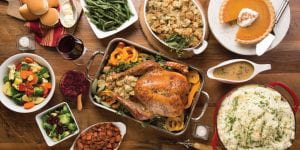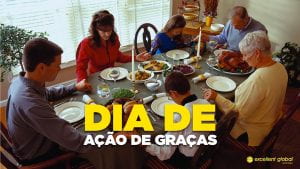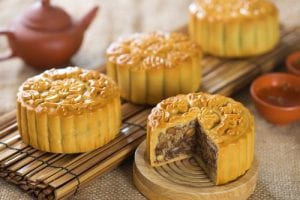Written by Yeyoung Lee, who is an international student from South Korea. Yeyoung is studying Nutritional Science and Dietetics at SJSU. This is the second in a series of 3 Thanksgiving blogs by students in the Nutrition and Food Science program, where they will share Thanksgiving traditions and healthy recipes. ISSS is excited to collaborate with Professor Jamie Kubota and her students on this project for International Education Week.
Thanksgiving Traditions Around The World
Photo by oliversmarket
Thanksgiving Day is as big a holiday in North America as Christmas and celebrates the year’s prosperous harvest. In the United States, Thanksgiving Day falls on the fourth Thursday of November. Other cultures that celebrate a holiday of “thanksgiving” in hopes of abundance include Canada, Brazil, Liberia, South Korea, China, and Japan… Each country observes following their national cultural traditions.
Canadian Thanksgiving Day
Photo by the holidayspot
Unlike the United States, Canada’s Thanksgiving Day falls on the second Monday of October, about six weeks ahead of the United States. Canadians often use the three-day Thanksgiving weekend to visit family or friends who live far away or to receive them in their own homes.
Many people also prepare a special meal to eat at some point during the long weekend. Traditionally, Thanksgiving foods included roast turkey and seasonal produce, such as pumpkin, corn and pecans, stuffing, mashed potatoes with gravy, sweet potatoes, cranberry sauce, pumpkin pie, and several autumn vegetables (mainly various kinds of squashes but also brussels sprouts). Now, the meal may consist of other foods, mostly if the family is of non-European descent.
Brazil’s Thanksgiving Day
Photo by excellent global
In Brazil, Thanksgiving Day also takes place on the fourth Thursday of November. Known as Dia de Ação de Graças, it coincides with American Thanksgiving. Although it is not an officially recognized holiday, this festival is celebrated by many families of American origin and by evangelical churches such as the Foursquare Gospel Church in Brazil. Those who celebrate gather with family and friends to eat turkey (“peru” in Portuguese) along with pumpkin pie and sweet or mashed potatoes. The foods served are usually similar to those served for the American holiday.
Thanksgiving Day in Liberia
 Photo by Africa Imports African Business Blog
Photo by Africa Imports African Business Blog
Thanksgiving Day is a public holiday in Liberia. The festival is celebrated on the first Thursday of November and follows the same traditions as Thanksgiving Day in the United States. It is a day to give thanks to God and Americans for freeing the slaves. In celebration, families gather together and enjoy roast chicken, green bean casserole, and mashed cassavas. Liberians usually eat their food hot and spicy, so cayenne and other peppers may be added to their Thanksgiving foods. As with all Liberian celebrations, there is plenty of music, song, and dance during the festivities.
South Korea’s Thanksgiving day (CHUSEOK)
South Korea’s Thanksgiving day is a major harvest festival and a three-day holiday celebrated on the 15th day of the 8th month of the lunar calendar on the full moon. Chuseok is commonly translated as “Korean Thanksgiving” in English. Like many other harvest festivals around the world, it is held around the autumn equinox. As a celebration of the harvest, Koreans share a feast of traditional foods such as songpyeon, hangwa, bulgogi, japchae, and assorted pancakes, and traditional Korean liquors like baekseju and rice wines (makgeolli). Songpyeon is a type of tteok (small rice cake) traditionally eaten during Chuseok. Traditionally, Songpyeon was made by families and relatives using freshly harvested rice. Songpyeon is shaped like a half-moon and tastes chewy, nutty, and a little sweet. As it represents the moon and wishes, it is traditional for people to say their wishes while making and eating it.
China Mid-Autumn Festival
Photo by Chinahighlight
The Mid-Autumn Festival or the Mooncake Festival is one of the most celebrated Chinese harvest festivals and includes a big feast. It is held on the 15th day of the 8th lunar month, which is in September or early October, similar to South Korea. Similar to Thanksgiving, the Mid-Autumn Festival is a time for families, friends, and relatives to hold reunions and enjoy the full moon that is a symbol of abundance, harmony, and luck. During the festival, Mooncakes are eaten and shared with friends and relatives as a way of giving thanks. In addition to enjoying Mooncakes, Chinese people enjoy music and dancing in celebration. Mooncakes are a traditional food Chinese enjoyed during the Mid-Autumn Festival. It often has a salted egg yolk in the middle to symbolize the full moon. Writing or patterns on top tell of good fortunes to come and longevity. Traditionally, Mooncakes contain a paste made from lotus seeds or beans and tastes sweet.
Japan Mid-Autumn Festival
In Japan, the Mid-Autumn Festival is called Tsukimi. Tsukimi is held on August 15th of the lunar calendar. It is also referred to as Jugoya, which symbolizes the night of the 15th. The holiday marks the harvest of the crops, and thanks are given to nature. Considered a solemn celebration, the Japanese celebrate in a relatively quiet and solemn manner. Tsukimi dango is the most traditional food associated with Tsukimi. These round rice flour dumplings are steamed and may include red bean paste. Traditionally they are displayed by stacking fifteen rice dumplings in a unique pyramid arrangement on a tray. Other foods associated with Tsukimi include chestnuts (kuri), taro (satoimo), and kabocha (Japanese pumpkin).
Thanksgiving Recipes
Thanksgiving Dinner on a Sheetpan (serves 4, or two with leftovers)
Roasting a whole turkey can be a bit intimidating even for seasoned cooks. Instead, try this recipe for a full Thanksgiving meal cooked together on one sheetpan and enjoy all the flavors of the holiday in a much more manageable and simplified form. Serve with cranberry sauce for a truly authentic American meal
Ingredients
For the dressing:
2 tablespoons butter
½ cup each chopped onion and celery
2 cloves garlic, minced
1 teaspoon poultry seasoning
4 cups cubed sourdough bread (slightly stale or dry is best)
1-1/2 cups chicken broth
1 egg, lightly beaten with a fork
Salt and pepper to taste
For the turkey:
1 2-pound boneless turkey breast
2 tablespoon softened butter
½ teaspoon poultry seasoning or dried thyme
Salt and pepper to taste
For the Sweet Potatoes:
2 large sweet potatoes
2 tablespoons butter
2 tablespoons brown sugar
Salt to taste
½ cup mini marshmallows
For the Green Beans:
1 pound green beans, washed and trimmed
1 tablespoon olive oil (or melted butter)
Salt and pepper to taste
Instructions
- Preheat the oven to 375° Line a ½-sheet pan with foil. Use a second piece of foil to create a “tray” of foil that covers half the sheetpan – and will hold the dressing and turkey.
- Prepare the dressing: Heat a large skillet over medium heat and sauté the onion and celery in the butter for 5-6 minutes until softened and just starting to turn golden brown. Add the garlic and poultry seasoning and sauté one minute longer. Transfer the cooked vegetables to a large bowl and stir in the bread cubes, chicken broth, beaten egg, ½ teaspoon salt and a good pinch of pepper. Allow this to sit and absorb the liquid while you prepare the turkey.
- Prepare the turkey: Remove the turkey from its package and season with salt and pepper. In a small bowl, stir together the butter and poultry seasoning (or thyme). Carefully loosen the skin from the breast and carefully use your hands to work half the butter under the skin. Rub the remaining butter over the top of the skin. Spread the dressing in an even layer onto the foil tray and then nestle the turkey breast on top of the dressing.
- Prepare the sweet potatoes: Wash the sweet potatoes well. Using a knife, pierce each sweet potato 5-6 times (this prevents them from exploding while roasting). Place the sweet potatoes on the other half of the sheet pan. Place the pan into the preheated oven and set a timer for 45 minutes.
- Prepare the green beans: Toss the green beans with the oil and salt and pepper to taste. After the timer goes off, remove the sheet pan from the oven. Test the sweet potatoes to see if they are done by inserting a paring knife into the thickest part – if it enters easily the sweet potatoes are done – remove them from the sheetpan. If not, leave them on the sheet pan and scoot them to the edge to make room for the green beans. Spread the prepared green beans in an even layer onto the remaining space on the sheetpan and then return the sheetpan to the oven and continue cooking until green beans are cooked and turkey has reached 165°F in the center (approximately 30-40 minutes longer. Note, if the sweet potatoes weren’t done yet, continue checking the sweet potatoes every 10 minutes and remove when softened).
- Finishing the meal: Once the turkey is cooked, remove the sheetpan from the oven. Remove the turkey breast to a serving plate and place a piece of foil over the turkey breast and allow it to rest. Remove the stuffing to a serving bowl. Remove the green beans to a separate serving bowl. Then, slice the sweet potatoes in half lengthwise to make 4 large sweet potato halves. Divide the butter and brown sugar over the potatoes and use a fork to mash them into the flesh, leaving the skins intact. Sprinkle the marshmallows evenly over the top. Return the sheet pan to the oven for 5-6 minutes until the marshmallows are lightly melted and starting to turn golden brown. Remove the baked sweet potatoes to a serving plate. Slice the turkey and enjoy!
Fresh Cranberry Sauce
Cranberries are indigenous to the Americas, growing widely across the Northwest regions. Used by both indigenous American people and settlers, the tart berries have become an integral component of the Thanksgiving traditions in America as they cooked into a sauce to accompany turkey or top desserts. If you are short on time, you can buy canned cranberry sauce – many American families actually prefer it. Simply open both ends of the can, push the jellied cranberry mixture out onto a serving plate, slice and enjoy!
Ingredients
1 12-ounce bag fresh cranberries, rinsed
¾ cup sugar
¾ cup water (or ½ cup orange juice and ¼ cup water)
Pinch salt
Instructions
- Place all ingredients in a medium-sized saucepot over medium-high heat. Cook, stirring occasionally, until the cranberries have burst and cooked into a sauce-like consistency (about 10-12 minutes. Transfer sauce to a serving bowl and cool before serving.
- Enjoy!
Makes ~ 2 cups cranberry sauce
Reference
Andrew, S. (2019, October 07). 6 ways Canadian Thanksgiving is different from the US holiday. Retrieved November 12, 2020, from https://edition.cnn.com/2019/10/07/world/canadian-thanksgiving-2019-trnd/index.html
Rodgers, G. (n.d.). Chinese Mooncakes May Be Heavy, but the Festival Is Lighthearted Fun. Retrieved November 04, 2020, from https://www.tripsavvy.com/chinese-moon-festival-1458337
Korean, 9. (2020, June 29). Chuseok in Korea (Korean Thanksgiving). Retrieved November 04, 2020, from https://www.90daykorean.com/chuseok-in-korea/
Luiz, V. (1970, January 01). Dia de Ação de Graças (Thanksgiving Day) – O que é e como é? Retrieved November 12, 2020, from http://www.englishforbrazilianpeople.com/2014/11/dia-de-acao-de-gracas-thanksgiving-day.html
Imports, A. (2015, September 26). Celebrating Thanksgiving Day in Liberia – November 5th. Retrieved November 12, 2020, from https://blog.africaimports.com/wordpress/celebrating-thanksgiving-day-in-liberia-november-5th/
Yoshizuka, S. (n.d.). Japanese Autumn Harvest Moon Festival Food and Traditions. Retrieved November 12, 2020, from https://www.tripsavvy.com/tsukimi-japanese-harvest-moon-festival-2031040



